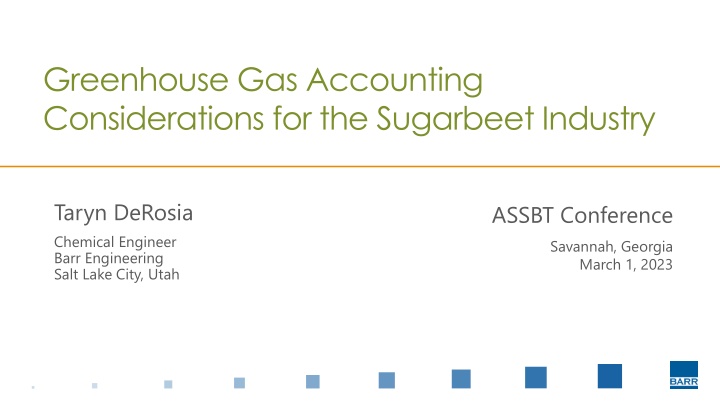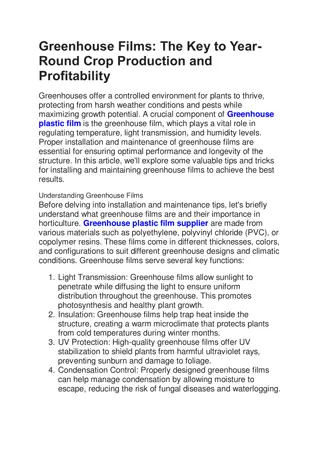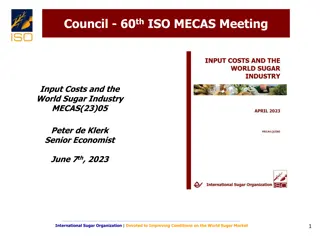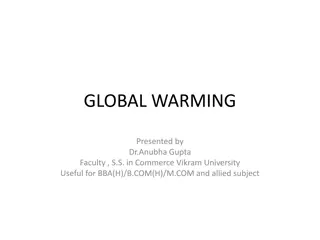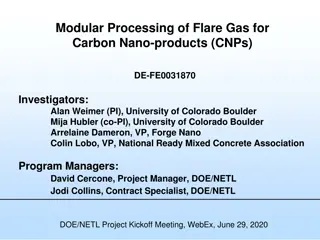Greenhouse Gas Accounting Considerations for Sugarbeet Industry
Explore the importance of greenhouse gas (GHG) inventories for the sugarbeet industry, including benefits, steps to develop inventories, and the significance of tracking GHG emissions. Learn about key gases impacting climate change and the role of GHG Protocol Organization Accounting Standards. Discover the internal and external advantages of developing GHG inventories for sustainability initiatives, investors, consumers, and industry compliance.
Uploaded on Sep 22, 2024 | 1 Views
Download Presentation

Please find below an Image/Link to download the presentation.
The content on the website is provided AS IS for your information and personal use only. It may not be sold, licensed, or shared on other websites without obtaining consent from the author.If you encounter any issues during the download, it is possible that the publisher has removed the file from their server.
You are allowed to download the files provided on this website for personal or commercial use, subject to the condition that they are used lawfully. All files are the property of their respective owners.
The content on the website is provided AS IS for your information and personal use only. It may not be sold, licensed, or shared on other websites without obtaining consent from the author.
E N D
Presentation Transcript
Greenhouse Gas Accounting Considerations for the Sugarbeet Industry Taryn DeRosia Chemical Engineer Barr Engineering Salt Lake City, Utah ASSBT Conference Savannah, Georgia March 1, 2023
Agenda What is a greenhouse gas (GHG) inventory? Benefits of developing a GHG inventory Steps to developing a GHG inventory 2
Agenda What is a greenhouse gas (GHG) inventory? Benefits of developing a GHG inventory Steps to developing a GHG inventory 3
What is a GHG inventory? Comprehensive inventory of GHG from a company s operations Emissions and Sequestration GHG s include: Carbon Dioxide (CO2) Methane (CH4) Nitrous Oxide (N2O) Other GHGs (SF6, HFCs, PFCs) Contribute to climate change 4
What is a GHG Inventory? A tool to track GHG emissions for a facility Identify trends Implement emission reductions Marketing Optional, separate from federally required reporting (40 CFR Part 98) Based upon GHG Protocol Organization Accounting Standards Global organization of businesses, NGO s, World Resource Institute, and World Business Council for Sustainable Development Establishing industry-accepted best practices for GHG accounting Ghgprotocol.org 5
Agenda What is a greenhouse gas (GHG) inventory? Benefits of developing a GHG inventory Steps to developing a GHG inventory 6
Benefits of Developing Greenhouse Gas Inventories Internal Sustainability Initiatives Investors Direct Consumers Sugarbeet Processors Food Product Manufacturers If not currently being requested, may be requested down the line 7 Direct Consumers
Agenda What is a greenhouse gas (GHG) inventory? Benefits of developing a GHG inventory Steps to developing a GHG inventory 8
Developing a GHG Inventory 5 Steps Step5 Step1 Step3 Step4 Step2 Determine Individual Emission Sources Set Operational Boundaries (Scope 1, 2, & 3) Update, Review, and Refine Set Organization Boundaries Quantify Emissions Steps developed based on The Greenhouse Gas Protocol Corporate Accounting and Reporting Standard 9
Developing a GHG Inventory Step 1: Establish Organizational Boundaries Step5 Step1 Step3 Step4 Step2 Determine Individual Emission Sources Set Operational Boundaries (Scope 1, 2, & 3) Update, Review, and Refine Set Organization Boundaries Quantify Emissions 10
Developing a GHG Inventory Step 1: Establish Organizational Boundaries Organizational boundaries considered for companies with multiple sectors or joint operations Consider organizational boundaries to avoid double counting Two companies holding interest in a joint operation Determine boundaries based on operational control or equity share 11
Developing a GHG Inventory Step 2: Establish Operational Boundaries Step5 Step1 Step3 Step4 Step2 Determine Individual Emission Sources Set Operational Boundaries (Scope 1, 2, & 3) Update, Review, and Refine Set Organization Boundaries Quantify Emissions 12
Developing a GHG Inventory Step 2: Establish Operational Boundaries Factory Outputs Agricultural Operations Factory Operations Sugar Beet Transport Agricultural Inputs Other Inputs 13
Developing a GHG Inventory Step 2: Establish Operational Boundaries Scope 1 Scope 2 Scope 3 Direct GHG emissions from sources owned or controlled by the company GHG Emissions from generation of purchased electricity consumed by the company Other indirect GHG emissions Fuel Combustion Process Emissions Company Owned Vehicles Farming Emissions Sugarbeet Storage Utility Providers Employee Travel Production of Raw Materials Waste Disposal Contractor Emissions *Start with Scope 1 and Scope 2 emissions, add Scope 3 emissions as possible 14
Developing a GHG Inventory Step 2: Establish Operational Boundaries Factory Outputs Agricultural Operations Factory Operations Sugar Beet Transport Scope 1 and 2 Emissions (Priority) Scope 3 Emissions (Difficult to Quantify) Agricultural Inputs Other Inputs 15
Developing a GHG Inventory Step 3: Determine Individual Emission Sources Step5 Step1 Step3 Step4 Step2 Determine Individual Emission Sources Set Operational Boundaries (Scope 1, 2, & 3) Update, Review, and Refine Set Organization Boundaries Quantify Emissions 16
Developing a GHG Inventory Step 3: Determine Individual Emission Sources Factory Outputs Agricultural Operations Factory Operations Sugar Beet Transport Scope 1 and 2 Emissions Vehicle fuel use Farm equipment fuel use Fertilizer application Crop residues Cover crops (Sequestration) Electricity use from utility providers Agricultural Inputs Other Inputs 17
Developing a GHG Inventory Step 3: Determine Individual Emission Sources Factory Outputs Agricultural Operations Factory Operations Sugar Beet Transport Scope 1 Emissions Vehicle transport between farm, piling grounds, and factory Agricultural Inputs Other Inputs 18
Developing a GHG Inventory Step 3: Determine Individual Emission Sources Factory Outputs Agricultural Operations Factory Operations Sugar Beet Transport Scope 1 and 2 Emissions Federally required reporting sources Fuel combustion Lime kilns Landfills Other non-reportable sources Factory vehicles Emergency generators Wastewater treatment Sugarbeet storage (respiration) Electricity use from Utility Providers Agricultural Inputs Other Inputs 19
Developing a GHG Inventory Step 3: Determine Individual Emission Sources Factory Outputs Agricultural Operations Factory Operations Sugar Beet Transport Scope 3 Emissions Waste disposal Transportation of products, wastes, materials sent offsite End use of products and byproducts Agricultural Inputs Other Inputs 20
Developing a GHG Inventory Step 3: Determine Individual Emission Sources Factory Outputs Agricultural Operations Factory Operations Sugar Beet Transport Scope 3 Emissions Fertilizer, pesticide, and herbicide manufacturing Chemical manufacturing Contractor activities Employee business travel Agricultural Inputs Other Inputs 21
Developing a GHG Inventory Step 4: Quantify Emissions Step5 Step1 Step3 Step4 Step2 Determine Individual Emission Sources Set Operational Boundaries (Scope 1, 2, & 3) Update, Review, and Refine Set Organization Boundaries Quantify Emissions 22
Developing a GHG Inventory Step 4: Quantify Emissions Emissions = Emission Factor x Activity Throughput Emission Factors Activity Throughput Site specific data where possible Monitoring data Analytical data Published Emission Factors EPA AP-42 40 CFR Part 98 IPCC Published Guidance Other publications, research, etc Engineering Judgement Site specific data where possible Monitoring data Accounting records Market Studies Engineering Judgement 23
Developing a GHG Inventory Step 4: Quantify Emissions Some calculation methods may be more complex Carbon sequestration from crops Beet respiration Fertilizer application Use best available data and make assumptions as needed Document sources and assumptions 24
Developing a GHG Inventory 5 Steps Step5 Step1 Step3 Step4 Step2 Determine Individual Emission Sources Set Operational Boundaries (Scope 1, 2, & 3) Update, Review, and Refine Set Organization Boundaries Quantify Emissions 25
Developing a GHG Inventory Step 5: Update, Review, and Refine Review Emissions Update Inventory Refine Calculations Develop Inventory Implement Emission Reductions 26
Summary A GHG inventory is a comprehensive analysis and quantification of GHG emissions from a facility s operations Challenges in developing GHG Inventory will be on sources without federal reporting requirements GHG inventories are an important tool to document, track, and implement sustainability objectives Demonstrate sustainability initiatives to key stakeholders 27
tderosia@barr.com Office: Salt Lake City, UT Thank you 801.333.8449 Barr.com for more information
